Digitalis purpurea
Purple foxglove, Digitalis purpurea, aka common foxglove or lady’s glove, is a biennial plant with tall flower stalks and tightly clustered, tubular, downward-facing blossoms.
Blossom colors include cream, pink, purple, red, yellow, and white, often accented by throats of a lighter hue, or speckles and mottling.
Digitalis is a genus in the Plantaginaceae or plantain family that contains about 20 recognized species.

We link to vendors to help you find relevant products. If you buy from one of our links, we may earn a commission.
D. purpurea is suited to cultivation as a biennial in USDA Hardiness Zones 4 to 9, and as an annual in all temperate zones. It grows as a short-lived perennial wildflower in coastal regions of the Pacific Northwest.
Let’s meet common foxglove!
What You’ll Learn
Cultivation and History
In 1755, English doctor William Withering used a folk remedy to treat a patient with a heart problem.
As the story goes, he obtained the remedy it from an elderly herbalist, one of many who had been using a concoction containing D. purpurea for years to treat wounds and dropsy – the swelling of the hands and feet that we now know is characteristic of certain heart conditions.

The doctor continued to experiment with foxglove leaf extracts, and by 1785 had introduced a treatment that eased angina heart pain.
At the same time, in Ireland, the anti-inflammatory properties of D. purpurea were also being studied.
In 1790, Charles William Quin, Physician General to His Majesty’s Army in Ireland, published “A Treatise on Dropsy of the Brain Illustrated by a Variety of Cases.”
The plant’s use as an anti-inflammatory heart medication evolved, and today we have a thriving commercial cultivation of D. purpurea for use in making digitalis, a drug prescribed to treat congestive heart failure and atrial arrhythmias. It works by increasing blood flow and decreasing hand and ankle swelling.
A Note of Caution:
All parts of this plant are poisonous. It contains cardiac glycosides that are toxic to people and pets if ingested.
While extracts of the leaves are used by knowledgeable practitioners in medicinal applications, ingesting this plant has potentially lethal consequences.
Many folks grow it simply for the statuesque beauty of its tall stalks, laden with large, intricately-detailed blossoms favored by nectar-seeking pollinators.
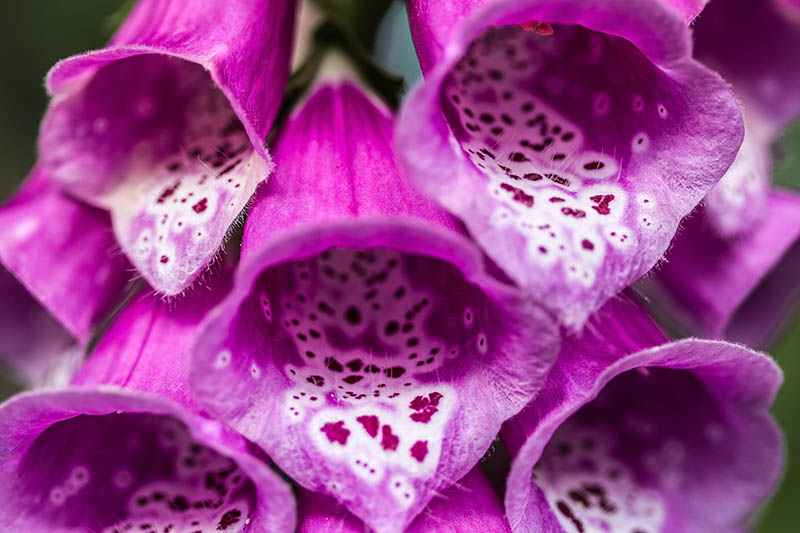
You may have thought foxglove was a perennial. That’s because it’s a prolific self-sower.
It is in fact a biennial. That means that in the first year, it grows a tight clump of lance-shaped leaves with shallowly scalloped margins at its base. This is called a rosette.
In the second year, the flower stalk rises from the rosette, followed by budding, blooming, and seed dispersal.
The exceptions to the second-year bloom are hybrids such as ‘Camelot’ and ‘Foxy’ that bloom in the first year and grow as annuals. However, since they self-sow, they still give the impression of being perennials.
Mature heights range from 18 to 60 inches, with a spread of 12 to 18 inches. Foxglove stems are very sturdy, and prized by many a floral designer.
The flowers are two to three inches long and hang downward like bells, attracting bees and hummingbirds that love to dive into their sweet depths.
Blossoms open from the bottom to the top of the flower stalk.
Ideal growing conditions include a location with part shade. Plants thrive in heat and humidity, provided they receive moderate moisture and are not overcrowded.
I have had good luck with them here in muggy southeastern Pennsylvania.
Bloom time ranges from early spring to first frost. As biennials, plants winter over in the first year before they bloom and set seed the second year.
Good drainage is essential, as roots are prone to rotting in saturated winter soil.
Foxglove Plant Propagation
You may start from seed or purchase nursery plants.
Seeds yield variable results, because seeds from hybrids do not replicate the traits of parent plants, and may even be sterile.
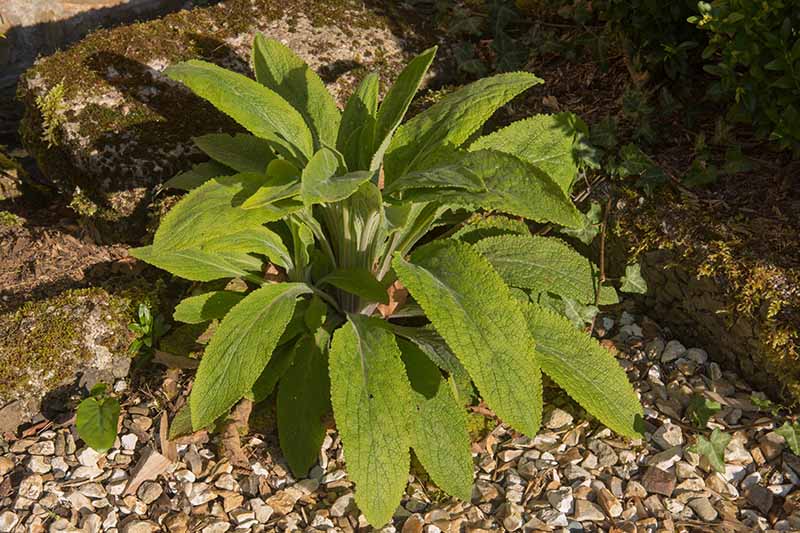
Nursery plants provide more certainty as to what you are going to get, with knowable characteristics.
From Seed
To propagate foxgloves this way, you’ll need to purchase seeds or collect them from a friend’s plant. Learn how to save foxglove seeds for next year here.
You can direct sow seeds in the garden after the danger of spring frost has passed.
Moisten the soil and sprinkle several seeds every 12 to 18 inches. Do not cover, as they need light to germinate.
Maintain even moisture for the next two to three weeks while seeds germinate.
When seedlings have two or more sets of true leaves, thin them out to a distance of 12 to 18 inches to accommodate mature dimensions.
Proper spacing promotes good air circulation and inhibits fungal disease.
Alternatively, start seeds indoors six weeks before the last average spring frost date and transplant them to the garden after all danger of frost has passed.
Before you plant out, acclimate seeds started indoors to the outdoors.
To do this, set them outside in a sheltered, partially shaded place for a few hours each day for four or five days.
Take care not to overwater them to avoid damping off, a fungal disease that thrives in cool, wet environments and kills seedlings.
Transplant the seedlings to the garden at 12- to 18-inch intervals. Keep the soil level of the seedling container even with the ground soil level to minimize transplant stress.
Tamp the soil gently around the seedlings and water them in well.
You may also direct sow seeds in late summer, at the same time they would naturally disperse.
From Nursery Starts or Transplants
Transplant from nursery pots to the garden after the last average spring frost date has passed.
If your nursery sells plants in late summer to early fall, you can also plant them out then.
To transplant, carefully work the plants out of their containers.
Set them into the soil so that the surface of the pot soil is even with the ground soil surface, for a smooth transition. Maintain spacing of 12 to 18 inches between plants.
Tamp the soil down around the plants and water in well.
Keep in mind that some cultivated varieties behave as annuals and bloom in the first year, while others are biennial or short-lived perennials that bloom the second year after experiencing a winter chill.
In addition, note that plants may cross-pollinate in the garden, causing color dominance or variations in the next generation.
Additionally, sometimes plants that bloom in the first year may bloom again in the second, so you may want to keep the plants in place at season’s end.
How to Grow Foxglove Flowers
When you have either seeds or plants in hand, you’re ready to find them a home and get growing.
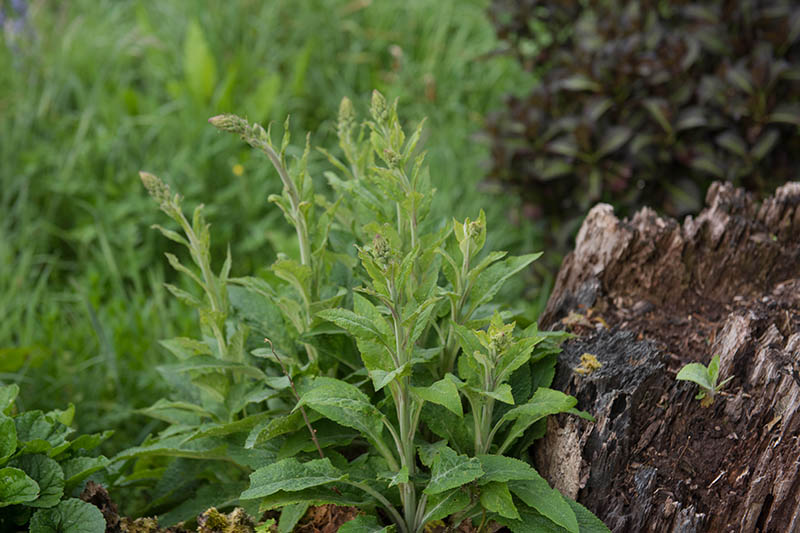
Select a location that gets morning sun and afternoon shade, particularly if you’re in a region with hot summer afternoons. In cooler regions, you may be able to plant in full sun.
The soil should be organically rich and well-draining. Mix in some sand or leaf mulch to loosen dense soil, and create a loamy consistency.
Work the garden soil to a depth of six to 12 inches.
Foxgloves prefer a slightly acidic environment, so conduct a soil test to determine the pH and nutrient levels of your soil.
A pH of 5.5 to 6.5 is ideal. Amend as needed.
Maintain even moisture during the growing season, but do not oversaturate. If it does not rain at least an inch per week, provide supplemental water.
Growing Tips
- Provide slightly acidic soil that is organically rich and drains well.
- Do not cover the tiny seeds; they need light to germinate.
- Space plants 12 to 18 inches to maintain good airflow.
Maintenance
There is a moderate amount of work to do to keep this plant in tip-top shape.
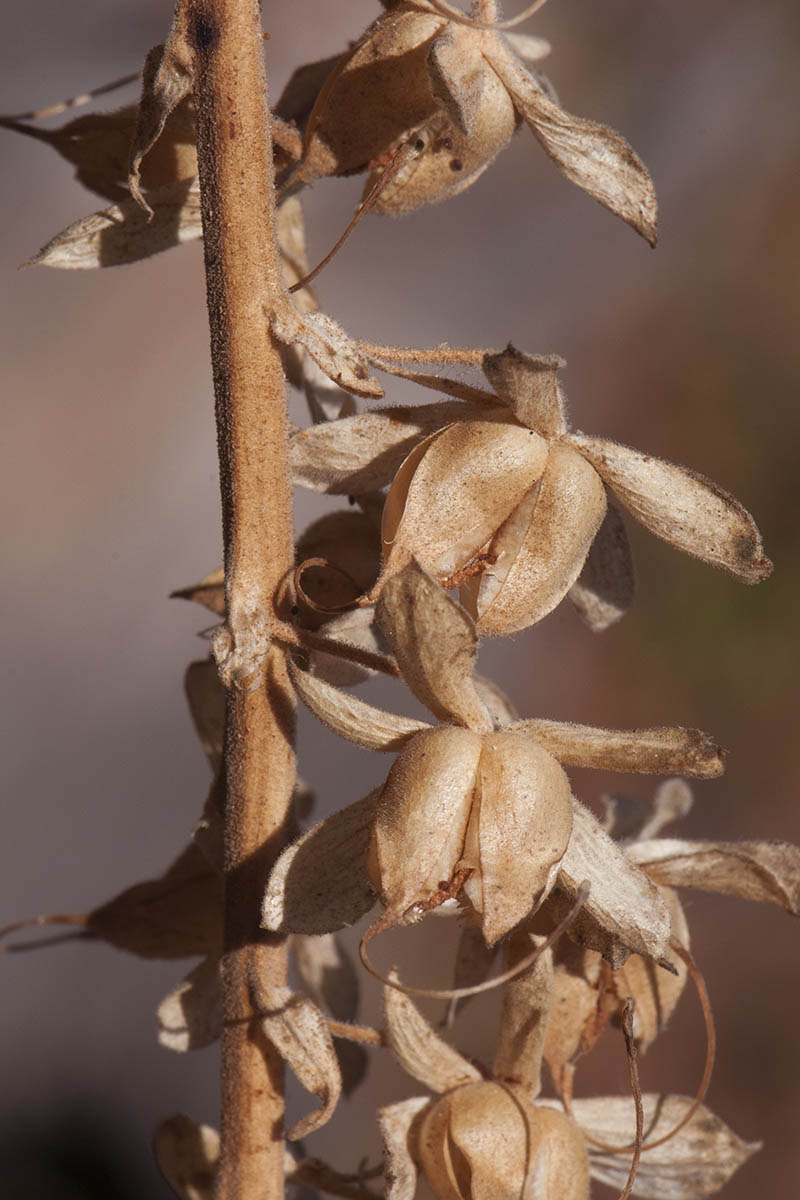
With mature heights of 18 to 60 inches, the stalks are likely to need staking, especially during wind and rain events.
If you don’t want your plants to self-sow, cut fresh stems to bring indoors or deadhead spent stems throughout the growing season.
This is a plant that likes to be kept moist, but not soggy. If it doesn’t rain at least once a week, provide supplemental irrigation.
In the early spring, add a two-inch layer of mulch to aid in water retention during the growing season. You may want to leave it in place during the winter months to help keep the roots warm.
However, if drainage is not good, the mulch may cause water to pool as the ground thaws and freezes, leading to root rot.
Some folks like to apply a well-balanced fertilizer, like a 5-10-5 (NPK), in early spring in the second year. A slow-acting granular product is best. Sprinkle it sparingly on the soil a few inches away from the new growth, and water.
If you are planting in organically-rich soil, fertilizer is not required.
In cooler regions, I do not recommend growing foxglove in containers, as biennials have a tendency to be very sensitive to damp conditions in winter, and pots that thaw and freeze repeatedly are likely to contribute to the rotting of roots.
You can learn more about growing foxglove in containers in this guide. (coming soon!)
Foxglove Cultivars to Select
When selecting seeds or nursery plants, make sure you read descriptions carefully, as many of today’s D. purpurea cultivars are bred to have features like blooming in the first year or sun tolerance.
Here are a few you’re sure to love:
Pam’s Choice
D. purpurea ‘Pam’s Choice’ features white flowers with burgundy-splashed throats. Interplanted with ‘Burgundy Bigalow’ poppies, the effect is stunning!
Ideally suited to gardens in Zones 5 to 9, this cultivar grows to a mature height of 48 inches with a spread of 18 to 30 inches.
‘Pam’s Choice’ blooms in spring and summer in a full sun to part shade location.
Find a set of four starter plants now from Burpee.
Rose Shades
D. purpurea ‘Rose Shades’ offers both rose and white blossom spikes for a two-tone display.
For gardeners in Zones 4 to 8, this type reaches mature dimensions of 30 inches tall and 18 to 24 inches wide.
Bloom time is spring and summer, and plants do best in part shade, but will tolerate sun placements.
Find four starter plants now from Burpee.
As mentioned, in addition to cultivated varieties of D. purpurea, you may also come across hybrids.
Some are hybrid crosses between D. purpurea and another species of Digitalis. Others combine D. purpurea with an entirely different species from the same family.
Here are examples of each:
Merton’s
Merton’s foxglove, Digitalis × mertonensis, is a cross between D. purpurea and D. grandiflora, a perennial species.

Blossoms are a copper-rose color and bloom time is late spring to early summer. Mature heights are three to four feet and widths are one to two feet.
Digiplexis®
Digiplexis® is a hybrid of D. purpurea and Isoplexis canariensis, the Canary Island foxglove.
Digiplexis® ‘Berry Canary’ is a unique cultivar with purplish-pink on the outside of the flower, and a yellow throat with burgundy spotting on the inside.
Bloom time is from late spring to first frost. Mature heights reach two and a half to three feet. Widths are one and three-quarters to two feet.
Find starter plants now from Burpee.
Want More Options?
Be sure to check out our supplemental guide: 11 of the Best Foxglove Varieties for Your Garden.
Managing Pests and Disease
For the best resistance to insects and infections, use quality purveyors for all your garden needs. Keep your equipment sanitized and your beds and borders tidy.
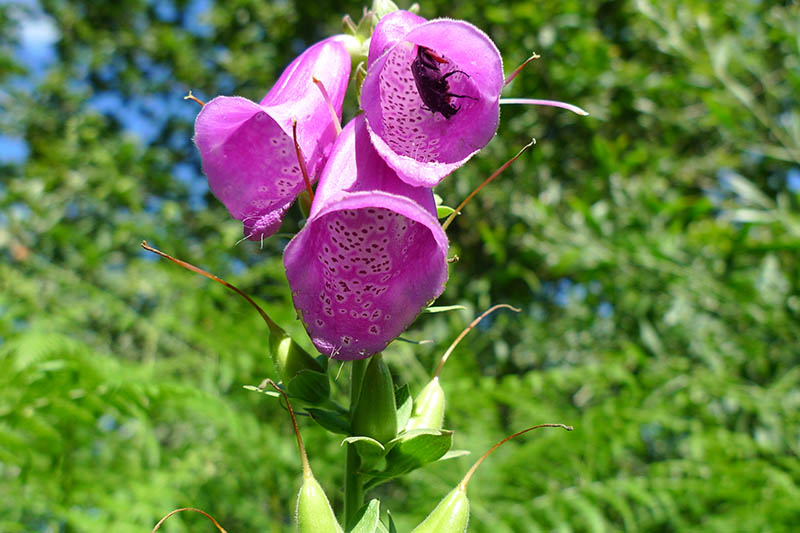
Be sure the soil drains well to avoid damp conditions that encourage pests like slugs and snails, and soil-borne fungal conditions, such as crown rot.
A preventative measure you can take against pests in the soil is to apply diatomaceous earth at planting time per package instructions.
As for the slimy little guys, handpick them, or set traps.
Space plants 12 to 18 inches or more, and keep the garden free from weeds and plant debris, to promote air circulation between plants and deter aggressive sap-sucking bugs like aphids, mealybugs, and Japanese beetles.
Handpick the bugs, or spray plants with a hose to dislodge them.
If all else fails, treat plants with neem oil, horticultural oil, or insecticidal soap.
Overcrowding creates a breeding ground for fungal and bacterial conditions like powdery mildew and leaf spot, more reasons to provide adequate spacing and keep the weeds down.
Treat fungal outbreaks with foliar applications of fungicides.
As for wildlife, foxglove is one plant rabbits don’t nibble and deer leave alone.
Best Uses for Common Foxglove
With its impressive heights and blossom-laden stalks, D. purpurea makes a bold architectural statement in the garden.
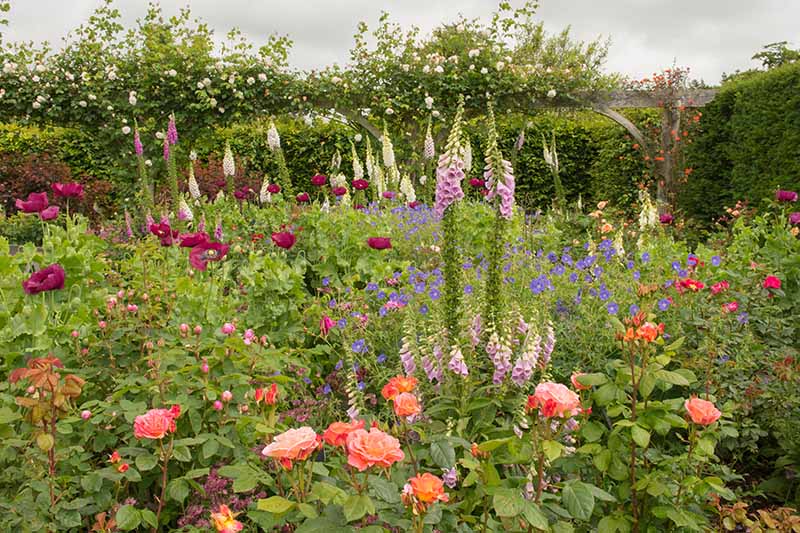
Because the flowers open from the bottom up, it’s nice to have companion plants in the foreground to cover lower stems that have finished blooming.
Use plants in rear-position foundation plantings, to draw the eye up nondescript walls to pretty windows above.
Pair foxgloves with companions that share their love of moist, organically-rich, slightly acidic soil and partial shade.
Offset the pointed clusters with the round heads of drumstick alliums, feathery plumes of astilbe, or spikes of salvia.
Give it room to naturalize in a cottage garden with flouncy Floribunda roses and ethereal poppies for more contrasts in form and texture.
Let it meander through woodland settings and shady borders, naturalizing with each year’s seed dispersal.
Add it to the cutting garden for a ready supply of robust, attractive stems that last a week or more in a vase.
You’ll enjoy an added benefit when you introduce D. purpurea to the garden, as it’s a magnet for pollinating bees and hummingbirds.
Quick Reference Growing Guide
| Plant Type: | Herbaceous biennial | Flower / Foliage Color: | Cream, pink, purple, red, yellow, white/green |
| Native to: | Europe, Mediterranean, Canary Islands | Maintenance: | Moderate |
| Hardiness (USDA Zone): | 4-9 | Soil Type: | Organically-rich |
| Bloom Time / Season: | Late spring to summer | Soil pH: | 5.5-6.5 |
| Exposure: | Part shade | Soil Drainage: | Well-draining |
| Spacing: | 12-18 inches | Attracts: | Bees, hummingbirds |
| Planting Depth: | Surface sow (seeds) | Companion Planting: | Astilbe, allium, Floribunda rose, poppy, salvia |
| Height: | 18-60 inches | Uses: | Beds, borders, cottage gardens, cutting gardens, foundation plantings, naturalize, shade gardens, woodland gardens |
| Spread: | 12-18 inches | Order: | Lamiales |
| Time to Maturity: | 2 years (some cultivars bloom the first year) | Family: | Plantaginaceae |
| Water Needs: | Moderate | Genus: | Digitalis |
| Tolerance: | Deer, rabbits | Species: | purpurea |
| Common Pests: | Aphids, Japanese beetles, mealybugs, slugs, snails | Common Diseases: | Crown rot, leaf spot, powdery mildew |
Uncommonly Captivating
If you’re intrigued by the whimsical tubular blossoms and intricate throat patterns of D. purpurea, it’s time to add it to your garden planner.
Remember that the ideal placement is a partially shaded location with organically-rich, slightly acidic, well-draining soil.

I’ve never forgotten my first foxglove. It was about two feet tall and the color of orange sherbet. This was back in the day when I didn’t save all the tags, so the cultivar name is lost to me. But like the frosty summer treat, I savor the sweet memory of it.
For a host of captivating blooms and a color palette any artist would envy, it’s just got to be the anything-but-common foxglove.
Are you growing foxgloves in your garden? Let us know in the comments below!
If you enjoyed reading about these showy flowers with exceptional vertical appeal, you’ll want to read these guides next:

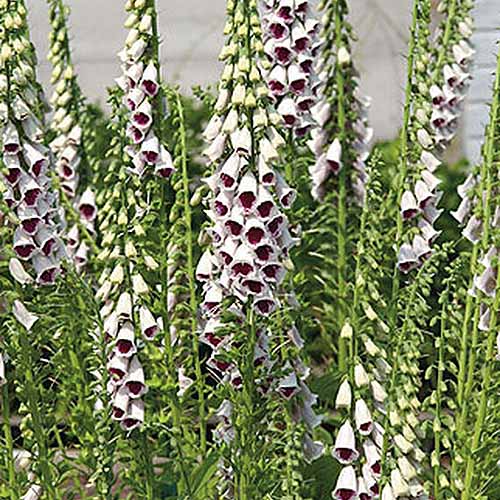

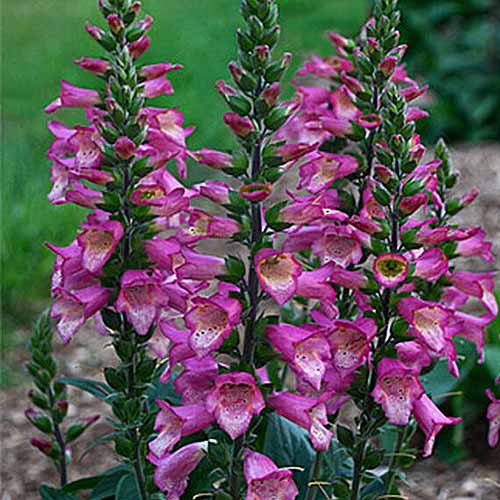



Thank you for the information. Purchased my first Foxglove today. Beautiful flower!
You’re welcome, Mary. That’s wonderful!
Hi! I have a question. I planted white foxgloves in my white garden and they self seeded, which I wanted. But, about half of the new foxgloves were a pale purple pink. How do I ensure only white foxgloves?
Hi Sarah –
You may remember from the article, in the propagation section, that we talk about seeds from hybrids producing variable results instead of replicating the traits of the parent plant. When a hybrid self-sows, individual characteristics of the plants used to develop the hybrid often come out. In your case, the purplish-pink common among foxgloves in the wild.
You may be able to snip the flower stalks off before they set and disperse seed, to prevent the self-sowing, but without the seeds that contribute to a biennial return, you may have few to no flowers in successive years.
My plants are in blooms but their leaves have become very yellow, not the deep green. Any advice?
Hi Evieta –
A lack of moisture can cause leaves to turn yellow and then brown before curling up and dropping off. However, it is unlikely that the flowers would be blooming well without enough water.
The yellowing is more likely the result of overwatering or excess rainfall. Too much moisture can cause crown rot, leaf spot, and powdery mildew, all of which can turn leaves yellow before they soften and rot.
If your region is experiencing excess rainfall, topdress the soil around the plants with compost to improve drainage.